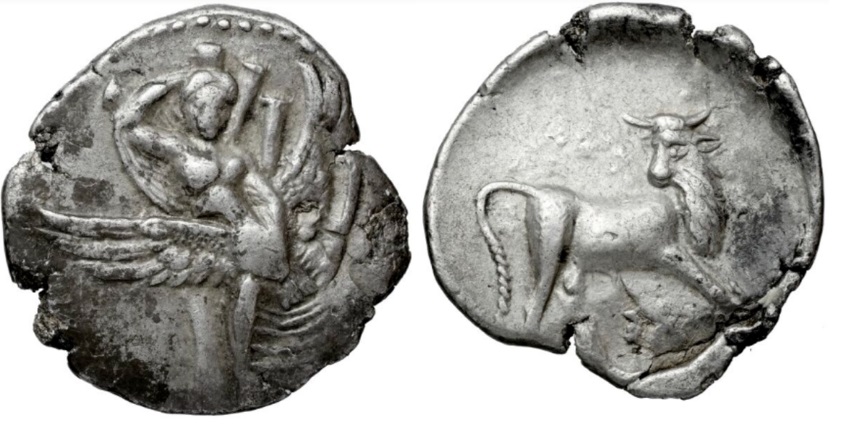1999 - Gortyn (stater Europa/bull) over Thebes (Dionysus/shield) (Paris, BnF, R 1317)
From SILVER
331 BCE - 270 BCE
Location/history
| Museum collectionMuseum collection: | Bibliothèque nationale de France, département Monnaies, médailles et antiques, R 1317 | |
Overstriking coin
Description
| ObverseInscription or printing placed on the obverse.: | Europa, nude to the waist, seated facing in tree, raising her veil with right hand, left arm holding eagle with spread wings in her lap. | ReverseInscription or printing placed on the reverse.: | Bull right, head reverted. Border of dots. |
Mint and issuing power
| MintIdentifies the place of manufacture or issue of a numismatic object.: | Gortyn | Ancient regionAncient region. | Crete | Modern countryModern country: Greece | AuthorityIdentifies the issuing power. The authority can be "pretended" when the name or the portrait of X is on the coin but he/she was not the issuing power. It can also be "uncertain" when there is no mention of X on the coin but he/she was the issuing power according to the historical sources: |
Chronology
| FromIdentifies the initial date in a range assigned in a numismatic context. 331 BCE toIdentifies the final date in a range assigned in a numismatic context.. 270 BCE | Hellenistic 323-30 BC |
Physical description
| MetalThe physical material (usually metal) from which an object is made.: Silver |
WeightWeight of the numismatic object (in grams). in grams: 11.2911.29 g <br />11,290 mg <br /> | DenominationTerm indicating the value of a numismatic object. Examples: tetradrachm, chalkous, denarius.: stater |
AxisDescribes the directional relationship between the obverse and reverse of a numismatic object.: 33 mm <br />0.3 cm <br /> |
| StandardStandard.: Aeginetic | |||
References
| Coin referenceReference of the Coin: | Le Rider 1960, p. 11, n° 8, pl. 1 | Coin series referenceReference to coin series study: | Svoronos 18901Svoronos 1890, p. 163-4, n° 66-8, Le Rider 19602Le Rider 1960, p. 11, n° 8, pl. 1, Le Rider 19663Le Rider 1966 |
| Coin series web referenceCoin series web references: | |||
Overstruck type
Description
| ObverseInscription or printing placed on the obverse.: | Boiotian shield, club across upper half | ReverseInscription or printing placed on the reverse.: | Θ-E diagonally across fields (Greek) Bearded head of Dionysos to right, wearing wreath of ivy |
Mint and issuing power
| MintIdentifies the place of manufacture or issue of a numismatic object. ᵖ: | Thebes | Ancient regionAncient region. ᵖ | Boeotia | Modern countryModern country: Greece | AuthorityIdentifies the authority in whose name (explicitly or implicitly) a numismatic object was issued. ᵖ: |
Chronology
| FromIdentifies the initial date in a range assigned in a numismatic context. 425 BCE toIdentifies the final date in a range assigned in a numismatic context.. 395 BCE | Classical 480-323 BC |
Physical description
| DenominationTerm indicating the value of a numismatic object. Examples: tetradrachm, chalkous, denarius. ᵖ: | stater |
StandardStandard. ᵖ: | Aeginetic |
References
| Coin type referenceReference to coin series study ᵖ: | HGC 44HGC 4, n° 1326 | ||
| Coin series web reference overstruckCoin series web references overstruck: | |||
Additional data
| Frequency of overstrikesFrequency of overstrikes: | frequent | Level of confidenceLevel of confidence of the identification: | strong |
| RemarksRemarks: | |||
References
- ^ Svoronos, Ioannes N. (1890), Numismatique de Crète ancienne, accompagnée de l'histoire, la géographie et la mythologie de l'île. Première partie, description des monnaies, 2 vol., Macon, Impr. Protat frères.
- ^ Le Rider, Georges (1960), "Monnaies grecques acquises par le Cabinet des Médailles en 1959", Revue Numismatique 6 (3), p. 7-35, pl. 1-3.
- ^ Le Rider, Georges (1966), Monnaies crétoises du Ve au Ier siècle av. J.-C., Paris, Geuthner, 345 p. and 42 pl.
- ^ Hoover, Oliver D. (2014), Handbook of Greek Coinage Series 4. Northern and Central Greece : Achaia Phthiotis, Ainis, Magnesia, Malis, Oita, Perrhaibia, Thessaly, Akarnania, Aitolia, Lokris, Phokis, Boiotia, Euboia, Attica, Megaris and Corinthia, sixth to first centuries BC, Lancaster, lxxi, 563 p.

